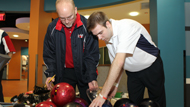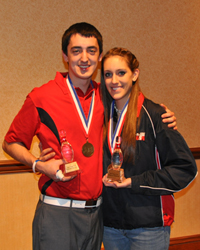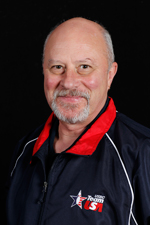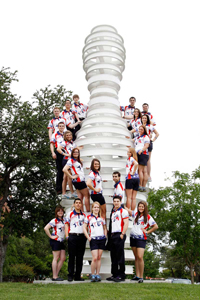ITRC hosts Junior Team USA Camp
May 04, 2012

ARLINGTON, Texas - The International Training and Research Center played host to the 2012 Junior Team USA Training Camp this week, where 20 elite players focused on everything from axis tilt and lane play to the importance of team work and accountability.
“This is the strongest group we’ve ever had on Junior Team USA,” head coach Rod Ross said. “The talent is very deep on this team; these are very skilled players.”
 That talent includes 2012 USBC Team USA Trials winners Danielle McEwan and Marshall Kent, who bowl for Fairleigh Dickinson University and Robert Morris University respectively. Their Team Trials titles qualified them to represent the United States at the 48th QubicaAMF World Cup in Poland this November, marking the first time both representatives of the U.S. at that event will be from the junior team.
That talent includes 2012 USBC Team USA Trials winners Danielle McEwan and Marshall Kent, who bowl for Fairleigh Dickinson University and Robert Morris University respectively. Their Team Trials titles qualified them to represent the United States at the 48th QubicaAMF World Cup in Poland this November, marking the first time both representatives of the U.S. at that event will be from the junior team.
“We’ve never had two players from the junior team win Team Trials,” Ross said. “That’s just phenomenal. The whole point is to develop these players and give them the experience of competing against world class talent. I look forward to it, and I think they’re going to do well.”
Perhaps no player epitomizes the depth of talent on Junior Team USA’s current roster than 14-year-old Kamron Doyle, who became the youngest player to cash in the history of the U.S. Open earlier this year and is the youngest player ever to qualify for Junior Team USA.
“I always dreamed of being the youngest one on the team, and for that to have come true at Team Trials feels amazing,” Doyle said. “Hopefully I get to go out and compete for my country.”
Junior Team USA members will await word on which eight players will get that chance to compete for their country at the 2012 WTBA World Youth Championships, which will be held June 22 – July 3 in Bangkok, Thailand. The team’s talent level may be an exciting prospect for Ross, but it also makes for some very tough decisions.
 “Choosing which players to take with us to the World Youth Championships will be one of the hardest decisions I have ever made,” Ross said. “Any of these players could start for us.”
“Choosing which players to take with us to the World Youth Championships will be one of the hardest decisions I have ever made,” Ross said. “Any of these players could start for us.”
A wealth of objective information will factor into that decision, much of it gathered during training camp this week, including data on everything from axis tilt and rev rate to ball speed, accuracy and even the players’ athleticism in the ITRC fitness center.
“They have everything here,” McEwan said. “They have the cameras that show your shot from different angles, the televisions with delayed replay that let you watch your shots, and coaches who practically are technology themselves with how intelligent they are and how much they can help you.”
But beyond the video analysis, hours of practice on various lane patterns and classroom discussions, it is the quality of the individual that Ross and the entire Team USA coaching staff emphasize most.
 “We spend a lot of time on that because it’s not just about bowling; everything you do counts in life,” Ross said. “From how you conduct yourself in line at the grocery store to how you merge into traffic, it all ties together. One thing they learn here is that who they are and what they do affects everything else. You can make excuses or you can be responsible for your actions; you can’t do both.”
“We spend a lot of time on that because it’s not just about bowling; everything you do counts in life,” Ross said. “From how you conduct yourself in line at the grocery store to how you merge into traffic, it all ties together. One thing they learn here is that who they are and what they do affects everything else. You can make excuses or you can be responsible for your actions; you can’t do both.”
The ITRC is home to some of the most innovative and cutting-edge coaching technologies available in the bowling industry today, including high-speed video cameras, motion-capture devices, foot-pressure sensors and goggles enhanced with cameras to show exactly where a player is looking during the approach and delivery. A DVR system also is in place and can record any video feed to let a bowler see what they did on their last shot as soon as they step off the lane.
A United States Olympic Committee-recognized training center, the ITRC is a joint venture of USBC and the Bowling Proprietors' Association of America. It is the most innovative and advanced training, research and testing facility in the sport of bowling with 14 lanes for training and six for research and testing.
For more info on the International Training and Research Center, click here.
“This is the strongest group we’ve ever had on Junior Team USA,” head coach Rod Ross said. “The talent is very deep on this team; these are very skilled players.”
 That talent includes 2012 USBC Team USA Trials winners Danielle McEwan and Marshall Kent, who bowl for Fairleigh Dickinson University and Robert Morris University respectively. Their Team Trials titles qualified them to represent the United States at the 48th QubicaAMF World Cup in Poland this November, marking the first time both representatives of the U.S. at that event will be from the junior team.
That talent includes 2012 USBC Team USA Trials winners Danielle McEwan and Marshall Kent, who bowl for Fairleigh Dickinson University and Robert Morris University respectively. Their Team Trials titles qualified them to represent the United States at the 48th QubicaAMF World Cup in Poland this November, marking the first time both representatives of the U.S. at that event will be from the junior team.“We’ve never had two players from the junior team win Team Trials,” Ross said. “That’s just phenomenal. The whole point is to develop these players and give them the experience of competing against world class talent. I look forward to it, and I think they’re going to do well.”
Perhaps no player epitomizes the depth of talent on Junior Team USA’s current roster than 14-year-old Kamron Doyle, who became the youngest player to cash in the history of the U.S. Open earlier this year and is the youngest player ever to qualify for Junior Team USA.
“I always dreamed of being the youngest one on the team, and for that to have come true at Team Trials feels amazing,” Doyle said. “Hopefully I get to go out and compete for my country.”
Junior Team USA members will await word on which eight players will get that chance to compete for their country at the 2012 WTBA World Youth Championships, which will be held June 22 – July 3 in Bangkok, Thailand. The team’s talent level may be an exciting prospect for Ross, but it also makes for some very tough decisions.
 “Choosing which players to take with us to the World Youth Championships will be one of the hardest decisions I have ever made,” Ross said. “Any of these players could start for us.”
“Choosing which players to take with us to the World Youth Championships will be one of the hardest decisions I have ever made,” Ross said. “Any of these players could start for us.”A wealth of objective information will factor into that decision, much of it gathered during training camp this week, including data on everything from axis tilt and rev rate to ball speed, accuracy and even the players’ athleticism in the ITRC fitness center.
“They have everything here,” McEwan said. “They have the cameras that show your shot from different angles, the televisions with delayed replay that let you watch your shots, and coaches who practically are technology themselves with how intelligent they are and how much they can help you.”
But beyond the video analysis, hours of practice on various lane patterns and classroom discussions, it is the quality of the individual that Ross and the entire Team USA coaching staff emphasize most.
 “We spend a lot of time on that because it’s not just about bowling; everything you do counts in life,” Ross said. “From how you conduct yourself in line at the grocery store to how you merge into traffic, it all ties together. One thing they learn here is that who they are and what they do affects everything else. You can make excuses or you can be responsible for your actions; you can’t do both.”
“We spend a lot of time on that because it’s not just about bowling; everything you do counts in life,” Ross said. “From how you conduct yourself in line at the grocery store to how you merge into traffic, it all ties together. One thing they learn here is that who they are and what they do affects everything else. You can make excuses or you can be responsible for your actions; you can’t do both.”The ITRC is home to some of the most innovative and cutting-edge coaching technologies available in the bowling industry today, including high-speed video cameras, motion-capture devices, foot-pressure sensors and goggles enhanced with cameras to show exactly where a player is looking during the approach and delivery. A DVR system also is in place and can record any video feed to let a bowler see what they did on their last shot as soon as they step off the lane.
A United States Olympic Committee-recognized training center, the ITRC is a joint venture of USBC and the Bowling Proprietors' Association of America. It is the most innovative and advanced training, research and testing facility in the sport of bowling with 14 lanes for training and six for research and testing.
For more info on the International Training and Research Center, click here.





